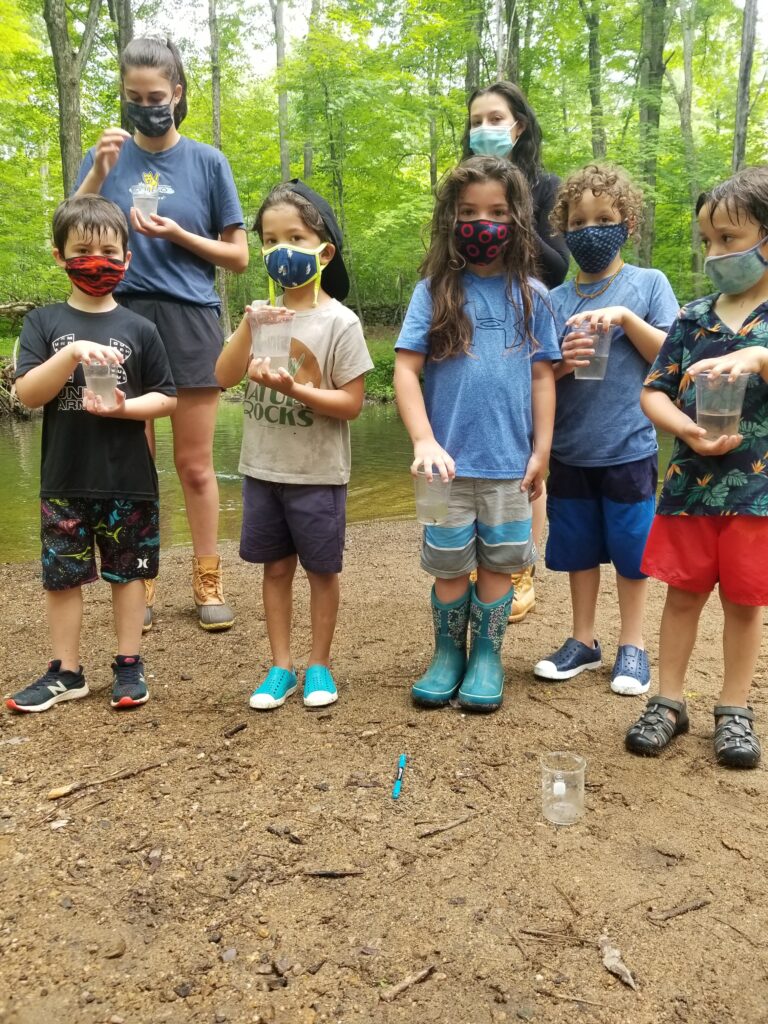- Written by Laurie Kay Scharett, TIC Teacher
- Courtesy of the NYC and NYC Watersheds TIC Program
NOTE: Students rotate through each station at approximately 20-30 minute intervals, depending on number of students in each group
Station 1: Habitat Mapping #
Objective: #
Students will use various art materials to create a “map” of the area of the waterway where the trout are being released.
Materials: #
- 12×18 sheets of oaktag paper
- 11×17 outline drawings of a streambed
- White glue and glue sticks – 1 per student
- Small pebbles or river stones (available in dollar and craft stores)
- Sticks and dried leaves (collected at site by students or teachers –depending on terrain of site))
- Crayons, markers or colored pencils
Procedure: #
1. Each student takes one outline map and uses glue stick to attach it to a sheet of oaktag. Use marker to write their name on the back.
2. Students study the area around them and compare it to the outline on their map. After discussing what they see, they color the map to show the water (blue), grassy areas (green) and areas of dried vegetation (brown). They may also indicate stands of trees, etc on or near the riverbank if desired. (It may be easier to strip crayons of paper to allow students to rub instead of coloring – saves time!) 3. Students then further study the actual waterway area, again noting things that they see – ripples, pools, shallow and deeper water, and any fallen trees or other obstructions that affect the stream flow. Discuss where the trout may find their “lie”, and where the water is being oxygenated by the riffles. Then have them use the white glue to attach pebbles, leaves and twigs to their map to simulate the streambed where they will release their trout. If desired, use permanent markers to label on their maps the “riffles” and “pools” and “lies”, as well as other vocabulary learned in the trout unit. 4. Place papers on the ground to allow the glue to dry.
Station 2: Dept of Environmental Conservation Presentation #
Background: #
Local environmental organizations and agencies are often eager to speak to groups, especially student groups, about the role of they play in protecting our living environment, and about how kids can help to do this too. Arrange for a short talk, and a Q&A with the students about water, land and natural resource conservation. Also as part of this station, kids did some policing of the area and picked up litter and other trash that had accumulated over the winter, to show environmental stewardship.
Materials: #
- Plastic trash bags
- Rubber gloves
Stations 3 & 4: Trout Prep and Release #
Prep Station: #
Gather the students in a semi-circle facing the water. Explain to them that they will be releasing 1 or more fish into the stream in front of them, but that there are some important steps to follow in order to allow the fish to acclimate themselves properly. Also, as scientists, they would need to collect data on the fish before releasing them (can be the last entry in the trout journal kept all year – filled with sketches, observations and wonderings). Discuss the temperature of the creek, and have students measure it. Sample stream macroinvertebrates, “fish food”, including caddis fly larva in their cases (found on sticks, leaf piles or small stones) and passed them around, showing the food the fish would eat in the wild. Review procedures for release and answer questions. Students, 2-3 at a time, come up to the bucket and received their fish in small baggies. They then return to where they were sitting, and journaling sheets, pencils, clipboards and rulers are passed out. Students observe, measure, reflect and get to name their fish while in the baggie.
Release Station: #
One group at a time was called up, put on life jackets (and plastic bag “waders” if needed – place one bag around each foot and secure at mid-calf with several wraps of masking tape – needed only if water temp makes it too cold for bare feet and rolled up pant legs!!) and proceeded to release point. They either lay down (on the waterproof cloth) and reached down into the creek to release, or waded into the shallow water. (If wading, place an adult downstream in case of falls). They held the baggie (with fish inside) in the creek for a slow count to 30, then opened the baggie and tipped it sideways to allow the fish to swim out (do not “dump” them!). Continue until all groups have released. You may want to have someone reading aloud a book (there are several listed below) about trout to keep everyone busy while they wait – before and after they release.
Materials: #
- Thermometers
- Journals/data recording sheets
- Pencils, rulers, and clipboards
- Plastic sheets or tablecloths as groundcover
- Plastic bags and masking tape (to make “waders” if releasing by kids in standing or crouched position)
- Life jackets (borrow from someone with a boat)
- Petri dishes or other containers for food samples
- Magnifying glasses to examine samples
- Plastic zip-loc baggies for releasing
- Garbage bag for collecting zip-locs
Books to read aloud: #
- Trout written and illus. by Charles L. Ripper. — New York : Morrow, 1966. Delacre, Lulu.
- Nathan’s Fishing Trip by Lulu Delacre. — New York : Scholastic, c1988.
- Trout Are Made of Trees by April Pulley Sayre ; illustrated by Kate Endle — Watertown, MA : Charlesbridge, c2008.







